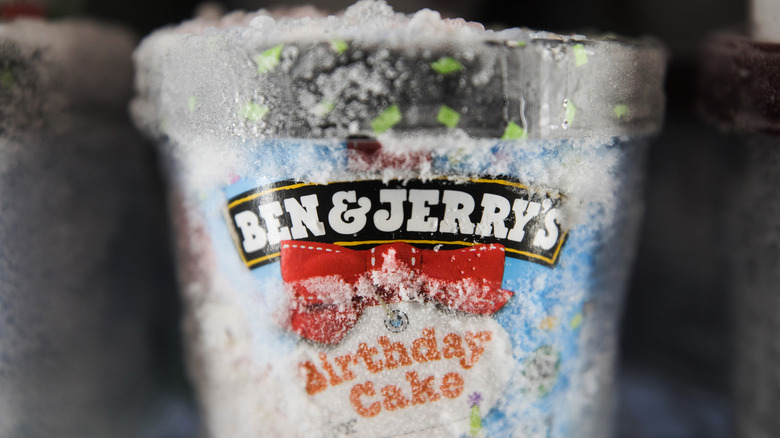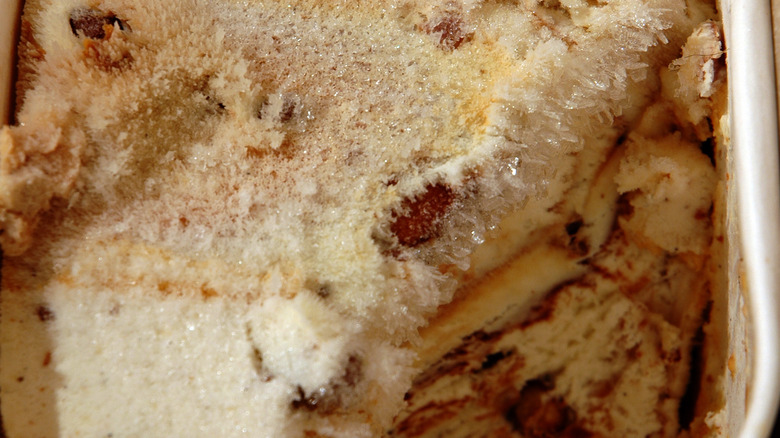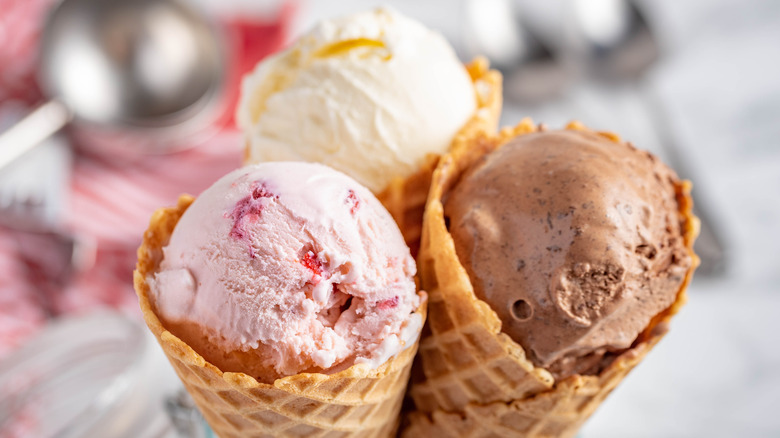The Ice Cream Storage Hack For Consistently Preventing Freezer Burn
Is there anything more heartbreaking than reaching into the freezer for a scoop of your favorite ice cream, only to find a rock-hard, crystalized mess? While freezer burn can ruin the texture and taste of even the most popular pints, there's a simple hack that will leave you with perfectly preserved scoops.
According to Ben & Jerry's, the secret to keeping ice cream fresh and freezer-burn-free is all in the storage. Never store pints in the door of the freezer — every time you open and close the freezer door, the temperature fluctuates, causing the ice cream to melt and refreeze. This process ruins the texture of the ice cream and creates those pesky ice crystals. To store ice cream for the long haul, consider stashing it in the back and out of the way of fluctuating temperatures.
But that's not the only hack that'll guarantee perfectly creamy scoops. Did you know that flipping pints upside-down can also prevent freezer burn? This simple trick can help redistribute any moisture that's collected on top of the ice cream (the culprit of freezer burn). With these tricks, you can enjoy fresh, creamy scoops every time.
What is freezer burn, anyway?
Rochelle Cooper, a pastry chef at The Duck & The Peach, discussed the process of freezer burn with Martha Stewart, explaining that "freezer burn on ice cream happens when free air in the container condensates as the freezer goes into its natural defrost cycle." Basically, it kickstarts the process of sublimation, which is when a solid turns directly into a gas without ever becoming a liquid, bypassing the melting phase. When tubs of ice cream are stored in the freezer door and left exposed to air, the moisture on the surface evaporates. This causes ice crystals to form.
Ice cream's flavor can also be affected by freezer burn. As the water evaporates, so does the flavor, leaving behind a bland, unappetizing version of the beloved dessert. (Still, as disappointing and annoying as it may be, the USDA notes that "freezer burn does not make food unsafe.")
Cooper went on to share her simple hack for preserving ice cream in the freezer that doesn't involve stashing it in the back or turning it upside-down. Place wax or parchment paper on top of the ice cream before sealing it with the lid. "When the ice cream is exposed, the small amount of water refreezes on top of the ice cream itself, creating those crystals you see," she explained to Martha Stewart. Her tip protects the porous part of the creamy dessert from that moisture.
Certain flavors are more prone to freezer burn
It all comes down to the composition of the ice cream. For example, you can cobble together a creamy base, pump it full of air, and end up with a light, fluffy frozen dessert. But more air also means a higher likelihood of freezer burn, as Frederick Aquino, pastry chef at The Standard, High Line, told The Takeout. When ice cream melts and re-freezes, those air pockets dissolve, leaving behind a dense, icy texture.
Ice cream's ingredients can play a role, too. Cutting down on cream and sugar might seem like a smart health choice, but it can also lead to a disappointing scoop. Jeni Britton Bauer, the founder of Jeni's Splendid Ice Creams, told Today that low-fat ice creams and those with high amounts of sugar and alcohol are more prone to freezer burn. This is partly because low-fat ice creams often contain stabilizers and emulsifiers.
So, what can you do? Don't throw the ice cream out. Just keep it in the back of the freezer and seal it properly. If you prefer the initial creaminess of a fresh pint of Chunky Monkey or Phish Food, Ben & Jerry's does offer another hack — grab a friend and finish it off in one sitting. We're down for that, too.


